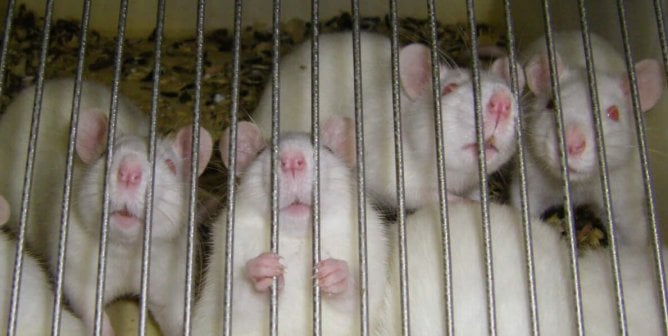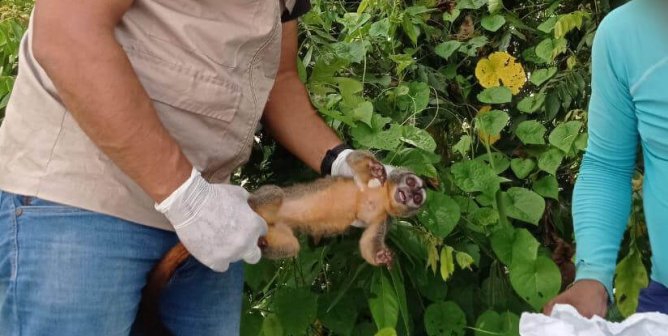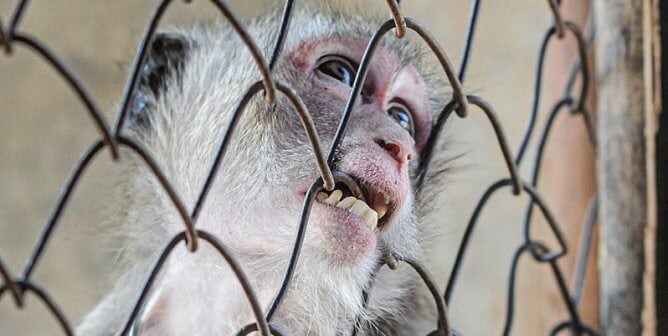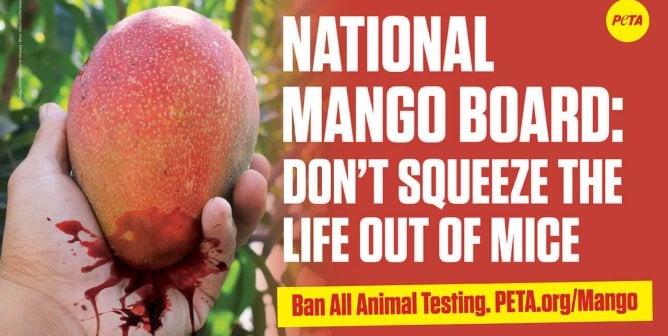The Grim Reality of Animal Experiments at Virginia Tech
Update (May 31, 2024): In a rare move, the U.S. Department of Agriculture just issued a penalty of $18,950 against Virginia Tech for seven violations of the federal Animal Welfare Act that occurred between February 4, 2021, and July 5, 2023. They include allowing a 6-day-old piglet to starve to death after she’d been separated from her mother, permitting such violent restraint of a gerbil by an untrained staff member that the animal couldn’t breathe and had to be euthanized, and failing to notify a veterinarian after pigs used in a traumatic brain injury experiment unexpectedly died, leading to “potentially preventable deaths and pain for the surviving pigs.” PETA filed a complaint with the National Institutes of Health when the violations were revealed in 2022. Virginia Tech receives tens of millions in taxpayer dollars from the agency each year, and it’s estimated that approximately half of those funds go to experiments on animals.
PETA is pulling back the curtain on taxpayer-funded animal experiments at Virginia Polytechnic Institute and State University (VT) to reveal shocking violations.
- Official Animal Welfare Concerns
- Number of Animals Used
- “Column E” Animals Used
- Examples of Animal Experiments
- Media Reports
- Public Funding
Official Animal Welfare Concerns at VT
Every year, VT—which includes the Fralin Biomedical Research Institute and the Virginia-Maryland Regional College of Veterinary Medicine—uses countless animals, including horses, sheep, cows, pigs, black bears, dogs, guinea pigs, hamsters, gerbils, rabbits, birds, bats, mice, and rats, in experiments. VT claims to adhere to the principles of the “3Rs”—Replacement of animal-based models with innovative (and more effective) technologies, Reduction of the number of animals used in experiments, and Refinement of scientific methods to minimize the pain and suffering of animals. The university’s website states that “alternatives should be considered in the planning phase of the animal use proposal” and includes a “Specialized 3Rs/Alternatives Databases” webpage.
The following issues are part of the official record kept by the federal oversight agencies responsible for ensuring compliance with animal welfare standards.
- “[A]nimal care staff discovered one deceased mouse, singly housed, [whose] death was not expected.” A “review concluded that replenishment of food may have been inadvertently missed for one to three days after the cage change.”
May 9, 2024, Self-Reported NIH OLAW Report (1P)
- “On October 16, 2023, animal care staff discovered four deceased mice [who] were group housed, [whose] deaths were not expected. It was noted that the cage [water bottle] was dislodged from the automated water supply line.”
May 9, 2024, Self-Reported NIH OLAW Report (1Q)
- “On November 15, 2023, animal care staff discovered six mice without food present.” “Two of the mice survived. A review of the incident found that the lack of food was due to a process error.”
May 9, 2024, Self-Reported NIH OLAW Report (1R)
- Multiple violations were reported after “bat field work was conducted outside of the United States in June and July 2023,” including the following:
- “[A]ll personnel assisting with the field work had fully completed the required training with the exception of one person.”
- “[S]ome personnel assisting with the field work were not identified in the approved protocol.”
- “[C]ertain Occupational Health and Safety reporting expectations were not met.”
- “The [principal experimenter] also submitted an adverse event report of the unexpected deaths of 15 bats over the course of the field work. It was reported that the cause of death could not be determined.”
- Pigs were “transferred to another protocol, which was not allowed on either protocol transferring from or receiving the animals.”
July 5, 2023, U.S. Department of Agriculture Animal and Plant Health Inspection Service (USDA APHIS) Inspection Report: One critical violation
- CRITICAL: “Inadequate training of animal husbandry staff regarding monitoring the health of gerbils led to three gerbils dying and two gerbils becoming ill and requiring supportive care.” The gerbils died during the acclimation period (within one week of arrival and prior to any experimentation). Two of them were found dead in cages, and one had to be euthanized.
April 26, 2023, USDA APHIS Inspection Report: One violation
- “A large amount of feces [from a small wild mammal] were observed along the back wall of the horse hay storage building,” resulting in a sanitation violation.
- A group of wild-caught birds were captured and not released as scheduled. The error was discovered the next day when “one bird was inadvertently left in a holding crate and died.”
February 13, 2023, Self-Reported NIH OLAW Report (1L)
- Multiple violations were reported after an experiment used wild-caught bats in Brunei, including the following:
- “[I]ndividuals participated in bat handling who were not approved and listed on the protocol.”
- Husbandry was provided by students not approved by the IACUC.
- “[Personal protective equipment] requirements were not enforced for individuals handling bats.”
- “[A]ppropriate veterinary care was not available.”
- “[T]he majority of bats captured, held, and manipulated were not approved species.”
- “[H]umane endpoints [the earliest point in an experiment when an animal may be euthanized] were not followed.”
- The protocol did not describe a euthanasia method, and the method used was not one approved by the American Veterinary Medical Association.
- “[T]he [principal experimenter] did not notify the IACUC of bat deaths.”
- According to OLAW, “The corrective actions consisted of the IACUC terminating the protocol due to the magnitude of infractions.” OLAW notified VT that the violations would be reported to the National Science Foundation, the experiment’s funding agency.
January 9, 2023, USDA APHIS Inspection Report: Four violations
- CRITICAL, REPEAT: Two protocols did not accurately or completely describe the activities being performed. In one experiment that exposed piglets to low oxygen conditions, there was “no record of blood sampling being performed” and their bodyweights and daily body condition scores hadn’t consistently been recorded as required. In another experiment, “facility personnel had not placed an IV catheter in a calf within 2 days of administering the infectious agent as was required by the protocol.” The calf became ill six days after infection, at which time the catheter was placed and fluids administered, but the calf “died shortly thereafter.”
- CRITICAL: A worker injured a gerbil “during a blood draw by restraining [him/her] too tightly,” even though the animal was already being held in a restraining device. “The staff member trainee used additional manual restraint to restrain the animal, not understanding that the restraint device alone was adequate.” The gerbil became nonresponsive in the restraining device, and the veterinarian conducting the training euthanized the animal.
- The facility’s 2022 annual report didn’t accurately report all animals used in or held for experiments. In addition, the school failed to report using 24 gerbils.
- The facility’s canine program of veterinary care didn’t include a vaccination schedule.
October 19, 2022, Self-Reported NIH OLAW Report (1K)
- Twenty-two hamsters “developed lesions after intraperitoneal [lower abdomen] injections with an unapproved” diluting agent.
July 26, 2022, USDA APHIS Inspection Report: Two violations
- A protocol involving research with Syrian hamsters didn’t include the administration of dimethyl sulfoxide (DMSO, a chemical solvent). Several hamsters used in the study “developed minor skin lesions on their abdomen in the same area as the DMSO was administered.”
- CRITICAL: A 6-day-old piglet died from starvation after the facility failed to ensure that (s)he had received sufficient nutrition to maintain proper body condition and health. The piglet had been removed from his or her mother before learning to feed on their own, and workers only occasionally offered supplemental milk by syringe feeding. “On day 4, the pig was described as sitting in the corner, quiet and with its head hanging down. When stimulated to move towards the milk bowl, the pig’s snout fell into the bowl.” On day six, the piglet was found dead. A necropsy found that the piglet had “a body condition score of 1/9” and was emaciated, and “the death was attributed to prolonged starvation.”
March 1, 2022, Self-Reported NIH OLAW Report (1I)
- “A bird was found dead after being mistakenly returned to [his or her] cage without food or water rather than euthanized” per the approved protocol.
February 1, 2022, USDA APHIS Inspection Report: Four violations
- The facility didn’t have a fully constituted Institutional Animal Care and Use Committee (IACUC) in 2021. A review of the monthly meeting minutes showed that the IACUC’s appointed unaffiliated (community) member—whose role is intended to represent general community interests in the proper care and treatment of animals—“was absent from every meeting” between June and December of 2021.
- “Several representatives from the facility expressed concern regarding the [Animal Resources and Care Division] veterinarian’s lack of access to euthanasia solution which prevented a sick calf from being humanely euthanized in a timely manner.” The 4-day-old calf became severely ill and was having difficulty breathing, so a decision was made to euthanize the animal. The calf “was treated with a sedative to address [his/her] suffering until a [College of Veterinary Medicine] veterinarian arrived an hour and a half later to euthanize” the animal.
- The Program of Veterinary Care for dogs didn’t specify a minimum frequency for the number of times the attending veterinarian would visit areas where animals were housed to assess the adequacy of veterinary care and other aspects of animal care.
- The enclosures used to transport 88 hibernating big brown bats in the fall of 2021 had insufficient ventilation openings, and ventilation wasn’t addressed in the approved protocol. “Adequate ventilation is necessary to ensure that enough fresh air is available for the health and well-being of the animals.” The only air exchange was via the space between the top lid and the enclosure.
June 29, 2021, USDA APHIS Inspection Report: Six violations (including one direct, for which VT received an official warning from the USDA)
- For a protocol involving “infecting animals with [a] virus and watching progression of the disease” and others involving “invasive surgical procedures,” the search for alternatives was not done correctly.
- A protocol “did not contain a complete description of the proposed use of the animals.” After “four out of six animals unexpectedly died during procedures,” the experimenter “attempted to troubleshoot the problem and made several manipulations to the study procedures,” which were not in the IACUC-approved protocol.
- DIRECT: USDA inspectors found an overweight cow lying on the ground near a fence, breathing rapidly and heavily. It was determined that she had suffered from “heat stress due to high humidity, being overweight and warm temperature.” It was noted that “natural shade and shelter areas (trees) for the cows were available but were far away from the cows and located down a hill, across parts of two pastures and up another hill.”
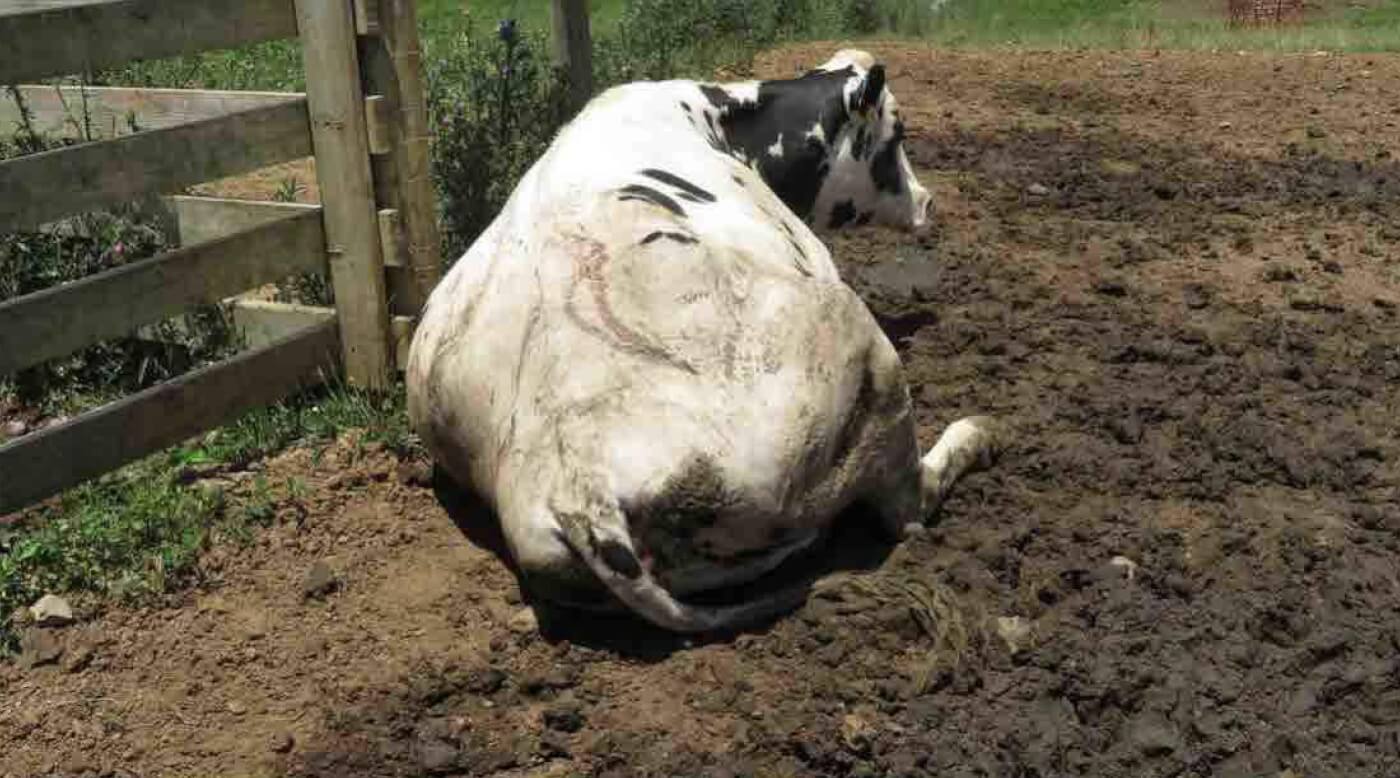
- An adverse event occurred when four of six Göttingen minipigs died during a procedure in an experiment “involving traumatic brain injuries.” The experimenters didn’t notify the veterinarian when the pigs began dying. The two surviving pigs exhibited abnormal neurological signs (incoordination, weakness, mental depression, and trembling). “The continued [experiment] manipulations and handling of the pigs after the initial unexpected death led to potentially preventable deaths and pain.”
- Housing for pigs (including pregnant sows) was in disrepair, including large cracks in the flooring and walls, “several pieces of metal protruding into pens, and rusting and disintegrating metal surfaces.”
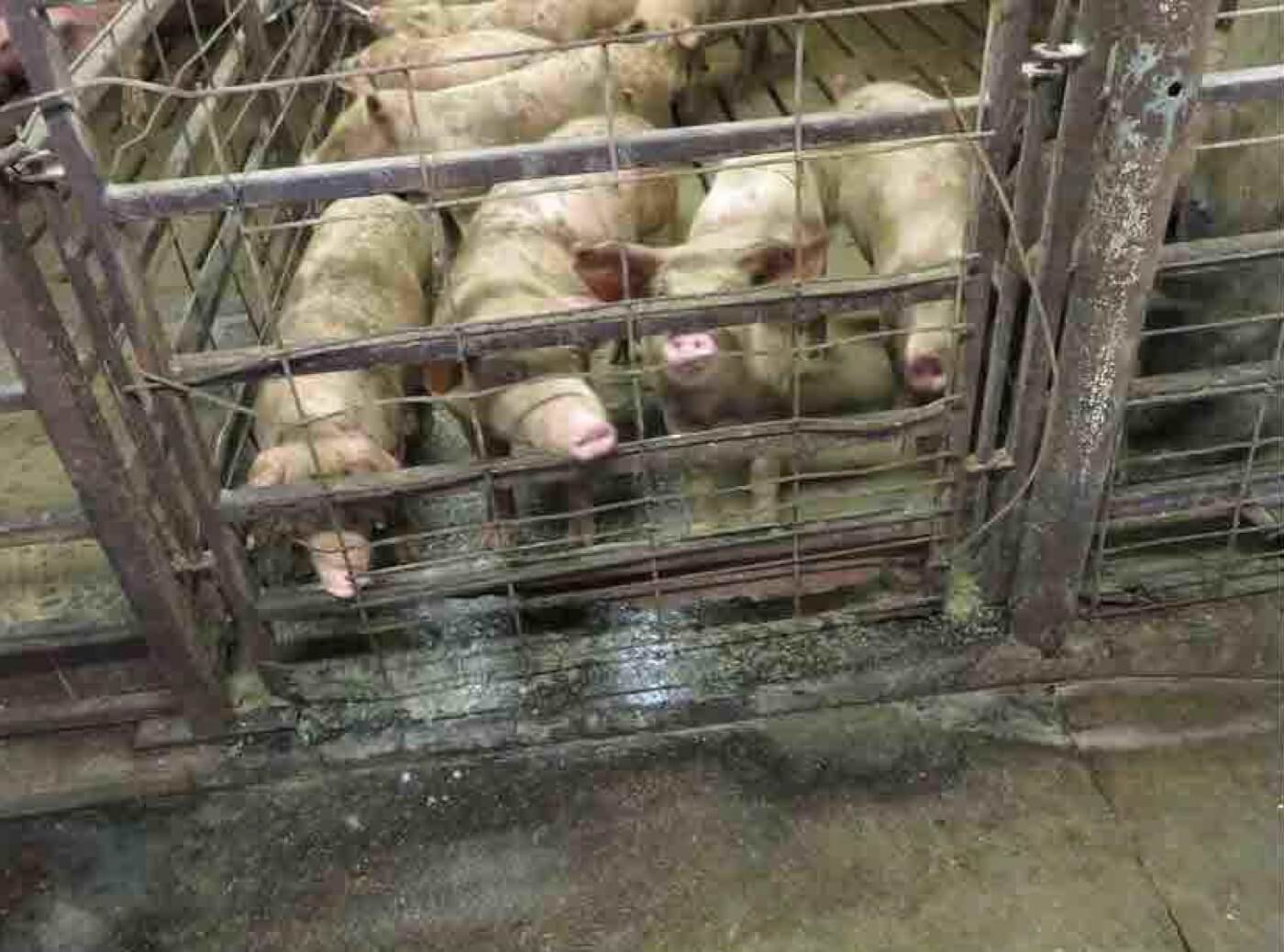
- “Seven sheep and five beef cow pastures [did] not provide shade by either natural or artificial means. In one sheep pasture an electrical power line casts a thin line of shade and the sheep were seen seeking shade in the narrow path.”
- A pool of standing water had been in a sheep barn for six months and contained “a large amount of floating hay, straw, and other unidentifiable debris. Water insects [were] present throughout the pool in significant numbers.”
January 24, 2020, Self-Reported NIH OLAW Report (1H)
- A worker failed to euthanize mice after they had reached their “humane endpoints” (defined as the earliest point in an experiment when an animal’s physical pain or psychological anguish may be stopped by the experimenter without compromising the experiment) “because of a communication error.” They were found dead.
- A “guinea pig was found dead due to complications of transportation stress-induced anorexia.”
February 25, 2019, Self-Reported NIH OLAW Report (1E)
- A “technician failed to ensure the death of [mice] after a euthanasia procedure.”
February 25, 2019, Self-Reported NIH OLAW Report (1F)
- A “lab technician had failed to ensure the death of [a mouse] after a euthanasia procedure.”
December 20, 2019, Self-Reported NIH OLAW Report (1G)
- A wild-caught flying snake “escaped and was not recovered” during an outdoor procedure. The approved protocol required that at least four workers be present to recapture the snake when he landed, but only three workers were on hand. The state herpetologist, who was notified, stated that “as a tropical species, [the snake] would not survive the winter.”
June 8, 2016, USDA APHIS Inspection Report: Three violations
- A protocol that included teaching veterinary students “cattle dehorning and castration, both procedures known to involve potential for pain and/or distress,” didn’t have documentation indicating that “a reasonable and good faith effort was made to determine the availability of alternatives or alternative methods.”
- REPEAT: Problems of animal health and well-being were not conveyed to the attending veterinarian in a timely manner. A cow wasn’t evaluated for a documented lame leg for 27 days, “at which time she was treated for an abscess.” Another cow was noted “to have a swelling on the 3rd eyelid. No medical evaluation or treatment records could be found.” Another cow was treated for horizontal hoof cracks, and the veterinarian recommended that the facility retrim her hooves in six weeks. “No record of retrimming or reevaluation was identified. Several cows were noted with longer than normal claws” on the same day.
- An animal-housing facility’s ceiling was peeling and “had a large and relatively deep hole,” door frames had “completely rusted off at the base,” and two pen gates had holes from excessive rust.
August 5, 2015, USDA APHIS Inspection Report: Three violations
- A cow used in a veterinary teaching lab was noted to be lame by students and staff, but “a clinical veterinarian was not contacted until five days later at which time the cow was diagnosed with a [ligament] tear. No drugs were given and the cow remained lame” six days later. On another occasion, “a bear with decreased appetite and foot pad ulcers on both front paws (due to pacing) was immobilized and evaluated during study procedures,” but a veterinarian was not consulted until several weeks later. During a USDA inspection, a pig was noted to be limping and had a bright red area of skin on his/her foot, but these observations were not reported to the veterinarian. “Staff stated that the clinical veterinarian would only be called if it got worse.”
- The total number of animals wasn’t accurately reported on VT’s 2014 annual report, including “an additional 34 dogs.”
- An enclosure housing black bears was inadequately constructed. Portions of the perimeter fence were too short, there were “numerous large trees adjacent to and within a couple feet of the perimeter fence that a bear could use to climb over the fence,” and gaps existed between the ground and the bottom of the fence. “In December 2014 a bear that had escaped from [an] enclosure was able to leave the facility by going under the perimeter fence. The bear ran into the woods.”
Number of Animals Used at VT
VT submits an approximate number of all animals used in experiments, including species not covered by the federal Animal Welfare Act (AWA), to the Association for Assessment and Accreditation of Laboratory Animal Care (AAALAC) International annually in order to maintain accreditation. According to the AAALAC annual report for 2022, species not covered by the AWA—mice, rats, birds, and cold-blooded species—accounted for 75.3% of the animals used at VT. The actual number used there and the percentage not covered by the AWA is undoubtedly much higher, because rather than counting individual mice, rats, and fish, the school counts cages or tanks—which typically house multiple animals.
| Type of Animal | Numbers Used |
| American least shrews | 10 |
| Amphibians | 11 |
| Big brown bats | 88 |
| Birds | 665 |
| Chickens | 240 |
| Cows | 274 |
| Dogs | 63 |
| Fish | 136 tanks* |
| Gerbils | 24 |
| Goats | 4 |
| Guinea pigs | 238 |
| Hamsters | 101 |
| Horses | 36 |
| Mice | 2,881 cages* |
| Pigs | 191 |
| Rabbits | 172 |
| Rats | 50 cages* |
| Sheep | 140 |
| Total | 5,324* |
*Multiple animals were kept in each tank or cage, so the number of animals who were used in experiments at VT in 2022 is surely significantly higher than the “total” of 5,324.
‘Column E’ Animals Used by VT
Animals who likely experienced pain or distress and who didn’t receive appropriate anesthetics, analgesics, or tranquillizing drugs are included under “Column E” in facilities’ annual reports. Experimenters must submit documentation to the USDA explaining their decision to deny these animals relief from their pain or symptoms.
- 2017: Column E Explanations
- Sixty-seven piglets were used in experiments in which they were infected with human norovirus, resulting in watery diarrhea, occasional vomiting, and dehydration. Signs of severe illness included “anorexia >48 hours, lethargy, sunken eyes, tented skin.” Experimenters stated that they wouldn’t provide the piglets with antibiotics, anti-inflammatories, or electrolytes “due to the importance of observing diarrhea” and “antibiotic treatment would invalidate results.”
- Twelve guinea pigs were infected with Zika virus. Symptoms of the infection included “fever, lethargy, hunched back, ruffled fur and decrease in mobility of variable severity.” Experimenters said providing the guinea pigs with antivirals would “alter the progression of the disease.”
- 2018: Column E Explanations
- Seventy-six piglets were infected with human rotavirus or norovirus, both of which result in watery diarrhea, occasional vomiting, and dehydration. Experimenters stated that they wouldn’t provide the piglets with antibiotics, anti-inflammatories, or electrolytes “due to the importance of observing diarrhea” and that “antibiotic treatment would invalidate results.”
- Sixteen guinea pigs were infected with Zika virus. Symptoms of the infection included “fever, lethargy, hunched back, ruffled fur and decrease in mobility of variable severity.” Experimenters said providing the guinea pigs with antivirals would “alter the progression of the disease.”
- 2019: Column E Explanations
- Thirty-four piglets were infected with human rotavirus, and they were “expected to experience watery diarrhea, and occasional vomiting.” Experimenters stated that they would not provide the piglets with antibiotics, anti-inflammatories, or electrolytes “due to the importance of observing diarrhea” and that “antibiotic treatment would invalidate results.”
- Twenty-eight pigs were infected with norovirus, and some received an inoculation after being infected. Symptoms included diarrhea, and only pigs who showed signs of severe illness, such as “anorexia >48 hours, lethargy, sunken eyes, tented skin” would be euthanized. Experimenters stated that they would not provide the piglets with antibiotics, anti-inflammatories, or electrolytes “due to the importance of observing diarrhea” and that “antibiotic treatment would invalidate results.” The experimenters said they wanted to “avoid supportive care and analgesics for all pigs in [their experiment] as [they] would like to keep each treatment group as consistent as possible.”
- Twelve pigs were inoculated with a virus and then “monitored closely for clinical signs including fever, milk consumption, weight loss, rhinitis, cough, wheezing and difficulty breathing.” Experimenters did not want to relieve any symptoms because the experiment was a “novel model and there [were] important data points to establish in this virus and disease.”
- 2020: Column E Explanations
- Eleven piglets were infected with a virus, and some received an inoculation after being infected. Symptoms included diarrhea, and only pigs who showed signs of severe illness, such as “anorexia >48 hours, lethargy, sunken eyes, tented skin” would be euthanized. Experimenters stated that they would not provide the piglets with antibiotics, anti-inflammatories, or electrolytes “due to the importance of observing diarrhea” and that “antibiotic treatment would invalidate results.”
- Twenty pigs were infected with a virus, and they were “expected to experience watery diarrhea, and occasional vomiting.” Experimenters stated that they would not provide the piglets with antibiotics, anti-inflammatories, or electrolytes “due to the importance of observing diarrhea” and that “antibiotic treatment would invalidate results.”
- 2021: Column E Explanations
- Ninety-six piglets were infected with a virus, and they were “expected to experience watery diarrhea, and occasional vomiting.” Experimenters stated that they would not provide the piglets with antibiotics, anti-inflammatories, or electrolytes “due to the importance of observing diarrhea” and that “antibiotic treatment would invalidate results.”
- 2022: Column E Explanations
- Seventy-one piglets were infected with a virus, and they were “expected to experience watery diarrhea, and occasional vomiting.” Experimenters stated that they would not provide the piglets with antibiotics, anti-inflammatories, or electrolytes “due to the importance of observing diarrhea” and that “antibiotic treatment would invalidate results.”
- Eighty-eight bats were infected with a pathogen. They were “expected to experience abnormal daytime activity and potential wing damage.” Experimenters didn’t provide the bats with pain relievers or anesthesia because it would affect “virulence metrics” (the degree to which a pathogen can cause disease).
- Forty-four calves were infected with an organism. Symptoms included “diarrhea, dehydration, and inappetence.” The experimenters stated that “without these clinical signs being exhibited by the calves to a degree, data concerning the clinical course of disease would be unavailable.” The calves would only receive treatment if they experienced “pain/distress to the level of not consuming at least 50% of their meals/day OR recumbency.”
Examples of Animal Experiments at VT
These experiments were recently conducted at VT, and many of them were publicly funded.
Effect of a single intra-articular injection of bupivacaine on synovial fluid prostaglandin E2 concentrations in normal canine stifles
Experimenters injected a local anesthetic into the knee joints of eight healthy adult male beagles, then took multiple samples of knee joint fluid during the 48 hours following the injection to determine whether the drug caused cartilage damage or osteoarthritis. An “important limitation” noted by the experimenters was that dogs with healthy joints were used, which “may not [have] accurately portray[ed] the response within a diseased joint,” the type of joint in which the drug “is most likely to be used.”
The dogs used in this experiment were purchased from Covance, a Cumberland, Virginia, beagle factory farm that had—under various owners—been breeding dogs and selling them to laboratories to use in experiments conducted all over the world since the early 1960s. In 2019, the facility was acquired by Envigo, and after years of repeatedly and severely violating animal welfare laws, Envigo closed its doors permanently in July 2022.
Mitral valve repair in dogs using an ePTFE chordal implantation device: a pilot study
Experimenters performed closed-heart surgery on six healthy female beagles to test the “feasibility and short-term effects” of an implantation device designed to insert artificial chords (tendon-like structures) into the heart. “One dog died intra-operatively because of aortic perforation,” and another one died shortly after surgery from hemorrhaging caused by “overly aggressive” anticoagulant treatment. The remaining dogs were subjected to weekly echocardiograms and killed 30 days after the surgery.
Ultrasound-guided catheterization of the femoral artery in a canine model of acute hemorrhagic shock
Experimenters induced hemorrhagic shock in five healthy adult male beagles via “blood removal,” and a catheter was placed in one of their femoral arteries. “Correct placement of the catheter was verified,” and then the dogs were killed.
Males and females differ in the regulation and engagement of but not requirement for protein degradation in the amygdala during fear memory formation.
Experimenters performed brain surgery on Sprague-Dawley rats (obtained from Envigo), injecting genetic material into their amygdalas. The rats were then placed into “fear conditioning chambers,” where an electric “shock” was delivered through the grid floor via a “Precision Animal Shocker” to induce a fear response. The rats were eventually killed.
Protection generated by prior exposure to pathogens depends on both priming and challenge dose.
Experimenters captured house finches from the wild and infected them with chronic respiratory disease-causing bacteria. Their blood was sampled multiple times during the “reinfection experiment.” The birds were then killed via an undescribed method.
North American house sparrows are competent for Usutu virus transmission.
Experimenters starved mosquitoes before feeding them bloodmeal containing a neuro-invasive disease-causing virus. Groups of chickens and wild-caught sparrows were also infected with the same disease-causing virus and restrained within the mesh of a mosquito carton, where starved mosquitoes fed on their blood. One bird “exhibited clinical signs of illness, including ruffled feathers, lethargy, and poor responsiveness, and was euthanized immediately.” After the experimenters drew blood, the birds were asphyxiated and their necks were broken. Necropsies showed that other birds in the experiment suffered from inflammation of the brain or heart and liver damage.
Monocyte proinflammatory phenotypic control by ephrin type A receptor 4 mediates neural tissue damage.
Experimenters cut open the heads of mice, irradiated them with X-rays, and fed them antibiotics for three days. They also drilled a hole into each mouse’s skull and “subjected [them] to the CCI (Controlled Cortical Impact) injury model” to cause traumatic brain injuries. For the next two weeks on multiple days, the experimenters placed the mice on a rotating rod, designed to be high enough that the mice would be unlikely to jump from it. However, it increased in speed until they fell off. “The time to fall was recorded for each mouse,” and the animals were then killed.
Media Reports Concerning Animal Testing at VT
- April 21, 2020: “Lawmakers reject Northam amendment that could have increased oversight of controversial dog breeding facility,” ABC8 News
- September 17, 2020: “PETA Seeks Investigation, Claiming Tech, UVA Misused State Funds With Animal Experiments,” Roanoke Times
- October 1, 2020: “Animal Rights Activists Question Virginia Tech’s Dog Purchases,” Virginia Mercury
- October 1, 2020: “Virginia Tech Buys Dogs From Controversial Breeding Facility,” ABC8 News
- September 1, 2021: “Federal Inspectors Issue Warning After Finding Animal Welfare Violations at Virginia Tech,” Virginia Mercury
- February 21, 2023: “Virginia bill would require animal testing facilities to submit info to the state,” The Virginian-Pilot
- June 12, 2023: “Amid ODU, EVMS, and Other University Citations, Virginia Senators Call For More Animal Testing Accountability,” The Virginian-Pilot
- February 8, 2024: “Bipartisan bill on animal testing transparency is downgraded to study after industry pushback,” The Virginian-Pilot
- June 23, 2024: “Tech laboratory fined $18,950 for animal abuse,” Collegiate Times
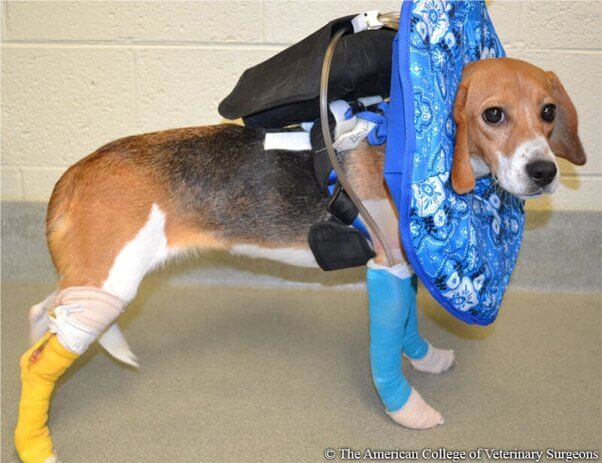
Public Funding for Experiments on Animals at VT
In 2021, the Commonwealth of Virginia and its localities gave public universities more than $130 million for animal and non-animal research. Currently, no information is available indicating how much money is spent on animal experimentation alone in Virginia. The table below shows the total annual research funds received by VT for the past eight years, including public funding.
VT spent $9,602 on AAALAC “accreditation” fees in 2023 alone.
| Year | State/Local Govt. | Federal Govt. | All Sources |
| 2014 | $52,197,000 | $204,308,000 | $513,149,000 |
| 2015 | $52,475,000 | $196,096,000 | $504,282,000 |
| 2016 | $58,517,000 | $195,859,000 | $521,773,000 |
| 2017 | $55,771,000 | $186,054,000 | $522,425,000 |
| 2018 | $56,479,000 | $199,897,000 | $531,636,000 |
| 2019 | $54,131,000 | $209,607,000 | $541,969,000 |
| 2020 | $61,192,000 | $210,792,000 | $556,341,000 |
| 2021 | $60,571,000 | $216,733,000 | $542,045,000 |
| 2022 | $75,010,000 | $240,305,000 | $591,861,000 |
Source: Higher Education Research and Development Survey, Table 83 for FY 2014, Table 82 for FY 2015, and Table 5 for FY 2016–2022


